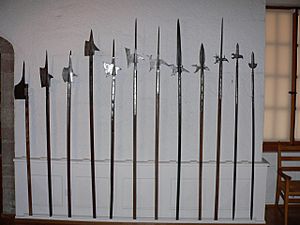Polearm facts for kids
Polearms were long weapons that combined a sharp blade or point with a sturdy wooden stick, called a "pole." Think of them as a mix between a spear and an axe, but much longer! They were used by warriors in many different cultures, including ancient Japan where women also trained with them.
Polearms were very important in battles for thousands of years. Their long reach helped soldiers keep enemies at a distance while still being able to attack with power.
Contents
What Are Polearms?
Polearms are basically any weapon that has a sharp part (like a blade, spike, or hook) attached to a long handle. This handle, or pole, could be anywhere from 6 to 20 feet long! The main idea behind a polearm was to give a fighter more reach and power than a sword or a short axe.
Why Were Polearms Used?
Polearms were popular for several reasons:
- Reach: They allowed soldiers to hit enemies from further away, keeping themselves safer.
- Power: The long pole helped create a lot of force when swung, making attacks very powerful.
- Versatility: Many polearms had different parts – a sharp point for thrusting, an axe blade for chopping, and sometimes a hook for pulling enemies down.
- Formation Fighting: In large armies, soldiers with polearms could form tight lines, creating a wall of sharp points that was hard for enemies to break through.
History of Polearms
Polearms have been around for a very long time, evolving from simple spears used by early humans.
Ancient Times
The earliest forms of polearms were simple spears. Over time, people started adding different kinds of heads to these spears.
- In ancient China, weapons like the ge (dagger-axe) and ji (halberd) were used thousands of years ago. These often had a blade sticking out from the side of the pole.
- Ancient Greek soldiers, called hoplites, used long spears called dory. Later, the Macedonians used even longer spears called sarissas, which could be up to 20 feet long!
Medieval Europe
During the Middle Ages in Europe, polearms became incredibly varied and popular. Knights in heavy armor were hard to defeat, so soldiers needed weapons that could pierce armor or knock them off their horses.
- Halberds: These were very common. They had an axe blade, a sharp spike, and often a hook on the back. They could chop, thrust, and pull.
- Glaives: A glaive was like a long knife blade attached to a pole. It was great for slashing.
- Bills: Originally farm tools, bills were adapted into weapons with a hooked blade and a spike.
- Pikes: These were extremely long spears, sometimes over 15 feet. They were used by large groups of soldiers to create a defensive wall against cavalry (soldiers on horseback).
Later Use
Even after firearms became common, polearms were still used.
- Pikes remained important for a long time, especially for defending against cavalry charges, even into the 17th century.
- Some polearms, like the partisan and spontoon, became more ceremonial. They were carried by officers as a symbol of rank rather than for fighting.
Types of Polearms
There were many different kinds of polearms, each designed for specific uses. Here are a few common ones:
- Spear: The most basic polearm, with a sharp point for thrusting.
- Halberd: A versatile weapon with an axe blade, a spike, and a hook.
- Glaive: A long, single-edged blade attached to a pole, good for slashing.
- Pike: A very long spear, used in tight formations.
- Bill: A hooked blade with a spike, often adapted from a farming tool.
- Naginata: A traditional Japanese polearm, similar to a glaive, used by samurai and warrior monks, including women.
Images for kids
-
Shang dynasty polearm weapon
-
Triple dagger-axe ji, Warring States period
See also
 In Spanish: Arma de asta para niños
In Spanish: Arma de asta para niños





